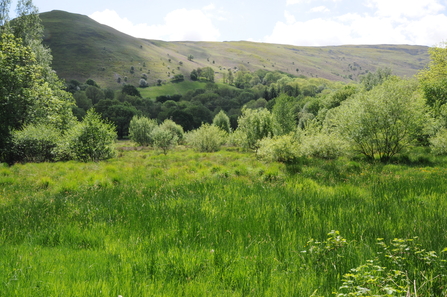Over two thirds of Wales is defined as grassland, areas dominated by grass cover, most of this in monocultural grassland, ‘improved’ (reseeded, fertilised or drained) for sheep grazing. ‘Unimproved’, or semi-natural grassland, which dominated much of the Welsh lowland landscape less than 100 years ago, has declined by 90% over the latter part of the 20th century, now only occupying 9% of the land area. This decline is due to developments, recreational use, and agricultural ‘improvement’ driven by land-use policies focused on agricultural production. Unimproved, species-rich grassland is still being lost, and butterflies, breeding birds, flowering plants and grassland fungi all continue to be in decline.
Aptly described species-rich meadows support a huge range of flowering plants, bird’s-foot trefoil, red clover, various orchid species and many other wildflowers are found in abundance when these habitats are well managed. Pollinating invertebrates feast in these areas, and in turn are prey for birds and mammals. Since the 1930s the UK has lost 97 percent of its meadows. Today roadside, footpath and garden verges are often the last refuge for plants, insects, and wildlife previously associated with meadows. Verges are too-commonly tidied up into lawns with neat borders. Radnorshire Wildlife Trust champions and campaigns for nature rich, biodiverse, and ‘scruffy’ verges.

Richard Knight
Wet grassland, such as fen meadows and rhos pasture, support the charismatic small pearl-bordered fritillary, and brilliantly purple devil’s bit Scabious. From 2021 to 2023 we ran the Rhos Pasture Restoration Project, which focused on restoring rhos pasture and increasing awareness about the habitat across Radnorshire. Rhos, a Welsh word meaning 'moor' or 'moorland', describe wet, marshy grassland. This habitat is widespread but declining in Wales, identified as a priority grassland habitat in Section 7 of the Environment (Wales) Act 2016. Focused on the northwest of Radnorshire, we worked with local farmers and landowners to survey and monitor the restoration of rhos pasture; improving the biodiversity, soil structure and carbon and water storage of the habitat.
Radnorshire Wildlife Trust manages many reserves that contain exceptional grassland habitat. Llanbwchllyn Lake boasts marsh orchids, devil’s bit scabious and lesser skullcap in its Fen meadow. A beautiful array of wildflowers such as betony, harebell, wood bitter-vetch and broad-leaved helleborine thrive on the sunny east-facing slopes with the old railway tunnel at Rhayader Tunnel. In the spring and summer, small pearl bordered fritillary, common blues, and green hairstreaks dance over the wildflowers at Gilfach, but many people visit the reserve for the grasslands in the autumn. Waxcaps, a brightly coloured group of fungi that take their name from the waxy texture of their caps, begin to appear out of the ground. Waxcaps, and other sensitive grassland fungi, are used as indicators of unimproved grassland as they are intolerant of agricultural ‘improvement’, thus are restricted to unimproved or semi-improved pastures. Gilfach boasts an impressive 20 different species of Waxcap, making the reserve a place of international importance for some of the rarest species.
